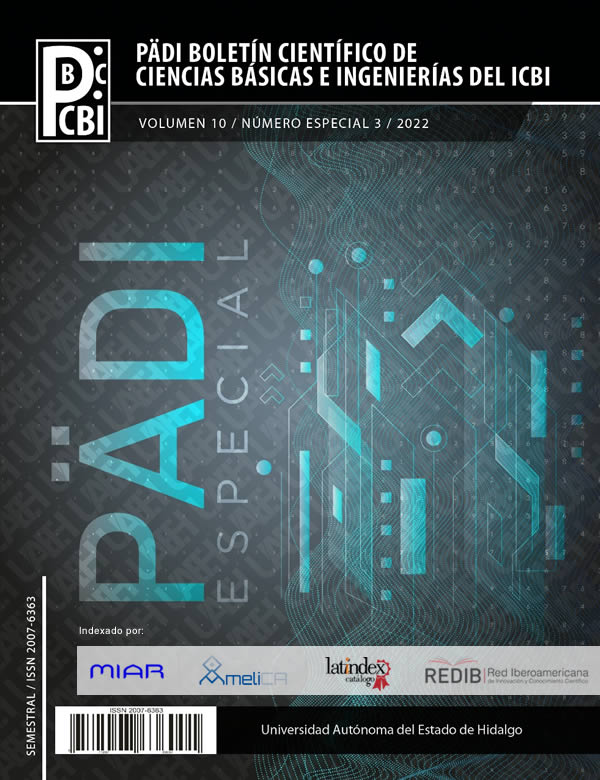IoT system and statistical validation for monitoring students’ health
Abstract
By blending the Internet of Things and the Statistics in Data Sciences, one can find interesting research and application areas, especially in the Educational sector. This paper proposes the implementation of a Health Station (kiosk) and
the analysis of biometrical data that an experimental procedure produces. Through the biometrical data, one can get the values of anthropometric variables that are useful to indicate the health status of some students of high school number 2 at the Universidad Autónoma del Estado de Hidalgo, México. In this first stage of the project, the paper proposes the measurement of the weight and height of students, to calculate the body mass index (BMI), and then relate it to other diseases. In order to acquire this information, weight and height sensors are required and the experimental results show that there are models that allow tests of normality and homogeneity of variances, which are useful to determine the type of statistics to use.
Downloads
References
Aishah, N., Yin, T. S., Othman, A. R., and Yaacob, C. R. (2011). Sensitivity of Normality Tests to Non–normal Data (Kepekaan Ujian Kenormalan Terhadap Data Tidak Normal). Sains Malay- siana, 40(6):637–641.
Ali, S. M. and Nihad, M. (May 2021). Internet of Things for Educa- tion Field. Journal of Physics: Conference Series, 1897(1):1–9.
Amaraweera, S. P. and Halgamuge, M. N. (2019). Internet of Things in the Healthcare Sector: Overview of Security and Privacy Issues. In Mahmood, Z., editor, Security, Privacy and Trust in the IoT Environment, chapter 8, pages 153 – 179. Springer.
Brown, S. (2008 – 2022). Measures of shape: Skewness and kurtosis. https://brownmath.com/stat/shape.htm
Brownlee, J. (2020). Continuous Probability Distributions. In Pro- bability for Machine Learning: Discover How To Harness Uncer- tainty with Python, chapter 9, pages 60–72. Machine Learning Mastery Books.
Doane, D. P. and Seward, L. E. (2011). Measuring skewness: A for- gotten statistic? Journal of Statistics Education, 19(2):18 pages. Hain, J. (2010). Chapter 3 Moment Tests for Normality. PhD thesis, In Comparison of Common Tests for Normality, Thesis at Julius– Maximilians–Universität Würzburg, Institut für Mathematik und Informatik, Lehrstuhl für Mathematik VIII (Statistik).
Jambu, M. (1991). 1–D Statistical Data Analysis. In Exploratory and Multivariate Data Analysis, chapter 3, pages 27–62. Acade- mic Press.
Joanes, D. N. and Gill, C. A. (1998). Comparing measures of sample skewness and kurtosis. Journal of the Royal Statistical Society. Series D (The Statistician), 47(1):183–189, 7 pages.
Juárez, E. A. O., Ávila Wall, L., and Acosta, L. R. S. (2014). Causas de Inasistencia a Clases de los Estudiantes– Caso: Estudiantes de la FCA de la UACH. In Memorias en extenso XV Congreso Asociación de Profesores de Contaduría y Administración de México (APCAM), page 19. Asociación de Profesores de Contaduría y Administración de México. http://www.fca.uach.mx/ apcam/2014/04/05/Ponencia%20111-UACH.pdf.
Kim, H.-Y. (February 26, 2013). Statistical notes for clinical resear- chers: assessing normal distribution (2) using skewness and kur- tosis. Restorative Dentistry & Endodontics, 38(1):52–54. https:
//www.ncbi.nlm.nih.gov/pmc/articles/PMC3591587/
Kim, R., Pathak, P. K., Tripathi, N., and Subramanian, S. V. (2020). Heterogeneity in adult anthropometry by socioeconomic factors: Indian National Family Health Survey 2006 and 2016. European Journal of Clinical Nutrition, 74:953 – 960.
Mara, C. and Cribbie, R. A. (2018). Equivalence of Population Va- riances: Synchronizing the Objective and Analysis. The Journal of Experimental Education, 86(3):442 – 457.
NIST (2022). 1. Exploratory Data Analysis/1.3. EDA Techni- ques/1.3.5. Quantitative Techniques/1.3.5.11. Measures of Skew- ness and Kurtosis. In Engineering Statistics Handbook, NIST/SEMATECH e-Handbook of Statistical Methods, chapter 1. http://www.itl.nist.gov/div898/handbook/.
Rayan, R. A., Tsagkaris, C., and Iryna, R. B. (2021). The Internet of Things for Healthcare: Applications, Selected Cases and Cha- llenges. In IoT in Healthcare and Ambient Assisted Living, pages 1–15. Springer.
Trivedi, M. (2017). Skewness and Kurtosis. Post–Graduate Di- ploma in Applied Statistics (PGDAST) community home page, MST – 002 Descriptive Statistics. In Block–1 Analysis of Quan- titative Data, chapter 4. eGyankosh– a National Digital Repo- sitory, India, Indira Gandhi National Open University.













